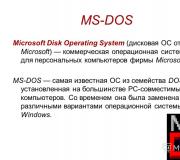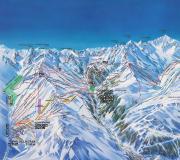How to unpack winrar zip archive. How to open a zip folder and save the resulting files
To make it easier to transfer folders containing a large number of files over the network, they are subjected to an archiving process, when they are packed into a single file with the maximum degree of information compression. Users who have downloaded this archive unpack it and only after that they get access to all the information and files it contains. Despite the fact that the Windows Vista and Windows 7 operating systems include a built-in program for creating and unpacking archives, it is inferior in its capabilities to third-party archivers such as WinRAR and 7Z.
If you often work with archives, we recommend downloading and installing one of the mentioned programs on your computer - WinRAR or 7Z. It's very easy to work with them.
How to unpack a RAR archive
It should be noted that the WinRAR archiver was created by a talented Russian programmer Evgeniy Roshal, has full support for the Russian language and differs in versions depending on the system you have installed. Download the appropriate archive with the program for your system in the form of an installation file from the official website rarlab.com and install WinRAR on your computer.

After installing WinRAR, all archive files on the computer will be associated with this program as the one used to open them by default, and their icons will look like the icon of the archiver itself.
The following items will be added to the context menu called when you right-click on an archive file: “Extract files”, “Extract to current folder” and “Extract to [archive file name]”.

The following items will also be added to the context menu called when you right-click on a regular file that is not an archive in its essence: “Add to archive”, “Add to archive [file name].rar”, “Add to archive and send via e-mail", "Add to archive [file name].rar and send by e-mail."

Accordingly, now, to unpack any archive, just right-click on it and select “Extract” from the context menu and specify the location where it will be unpacked. To create an archive, you need to click on any file or folder that contains a number of files and select the appropriate method of adding to the archive from the context menu. We will not describe the difference between each method, since in practice you yourself will very quickly understand their nuances and find the most convenient option for yourself.
WinRAR is considered one of the best archivers, providing good speed, high levels of information compression and unpacking a large number of different archive formats.
How to unpack a 7Z archive
The 7-Zip archiver was developed by Ukrainian programmer Igor Pavlov. On the official website of the program 7-zip.org.ua you also need to select the installation file that matches your operating system. After the file is saved, install the program on your computer.
The menu of the program itself is well Russified, but for some reason the context menu is in English. But it's easy enough to figure out. “Extract files” - unpack files, “Extract Here” - unpack here into the current folder, “Add to archive” - create an archive.


Just like WinRAR, this archiver has a large number of supported formats and provides a high compression ratio. True, in the latter case, it is necessary to make a reservation and say that all archivers achieve good compression mainly on text-type files. Multimedia files are practically not compressed when packed into an archive by any archiver.
Compressed files are much smaller in size than those that are not in the archive. Thanks to compression, you can not only save space on your computer’s hard drive, but also improve its performance (the PC will start up much faster if there is little data stored on local drives). Many people prefer to exchange information by transferring it in a ZIP file (less volume, higher transfer speed).
What to do if you receive such an archive? If interested, read about how. How to extract information from it,
Standard Windows tools
The Windows operating system has a built-in unpacking program. Having learned how to extract files from an archive, you will be able to work comfortably and without problems with the ZIP format. In Explorer, select the zipped file, for example, debug.zip.
Right-click on it and select “Extract all” from the context menu.

Click the “Browse” button and select where it will be unzipped. Click the “Extract” button. That's all the unboxing.
WinRAR program
Preparation at work..So, you will need the following: A program whose function is to unpack the archive and extract compressed files. Nowadays, a lot of such applications have been created, the most popular among them is the WinRAR program. You can download it at . WinRAR is a Shareware software - after 40 days, when the trial period expires, you will be asked to purchase a license.
But a real Internet user will also find a “cracked” option, for example. (I did not advise you to do this! For informational purposes only). When you finish installing the program, you may need to restart your computer. After this, you can begin unpacking the archive itself.
It is very easy to use, the interface is understandable even for novice users. The archive that needs to be unpacked is distinguished from others in the list of files by a shortcut in the form of a stack of books or a folder with a zipper (if you have Windows XP installed. Do you still have XP installed?). 
The easiest way is to click the “Extract” button. 
Select the destination folder and click OK.
But you can do this. Find the ZIP archive on your computer. How to recognize him among others was discussed above. It is better to move the archive in advance to a separate folder, where it will not get lost among the rest. Why else is this needed, you will understand a little later. So, the archive has been found - now you need to right-click on it.
 In the drop-down menu you will see two new items - “Extract files...” and “Extract to current folder”. If you choose the second option, the unpacking will begin automatically, and all files from the archive will immediately appear in the same folder where the archive itself is located. Selecting the “Extract files…” item brings up a pop-up window of the WinRAR program called “Path and Extraction Options”.
In the drop-down menu you will see two new items - “Extract files...” and “Extract to current folder”. If you choose the second option, the unpacking will begin automatically, and all files from the archive will immediately appear in the same folder where the archive itself is located. Selecting the “Extract files…” item brings up a pop-up window of the WinRAR program called “Path and Extraction Options”.
There you can choose the future location of the extracted files, as well as the mode for updating and overwriting them. Shutdown. After the window showing the extraction progress disappears, you can look at the folder selected as the “destination”.
There you will see all the files that the program provided after unpacking. The archive itself with compressed copies of the same files still remains on the computer. It's better to remove it, because... it's simply no longer needed. As you can see, extracting files from a ZIP archive is very simple.
But the WinRAR program can be useful not only for this. With its help, you can not only unpack a ZIP archive, but also create something similar yourself, as well as add files to an existing one. However, this will be discussed another time.
Good day, dear readers! In this article I will tell you how to unzip a rar, zip, 7z, tar, bz2 or any other archive file. Why do I say “any other”? Because there are many archiver programs, but they all have a common purpose. To ensure that files take up less space, they are placed in an archive.
Something like a folder into which you can add both files and other folders. Therefore, you may find that you do not know how to do this procedure after, for example, downloading a movie or program from the Internet that has a lot of weight. After reading my detailed instructions, this question will no longer worry you, because this procedure is very simple!
I'll look at a few of the easiest to use programs.
WinRAR archiver
The most famous program for extracting files from an archive is WinRAR. You won't believe it, but it is the most popular program after the operating system or browser, because most files on the Internet are stored in archives! This is convenient not only for website authors, like me, but also for users who download many files in one archive.
Since there are a lot of different archives on the Internet, users who do not have any archiver installed do not know how to unpack the file!
WinRAR's popularity is also due to the fact that it is a more intuitive archive program for novice users. Although in one of my tests I was convinced that a clear interface does not mean that this program can be considered the best to use.
So let's get started. Download the program from and install. Select “Install” in the window that appears, then “OK” and finally click “Finish”.
Now let's move on to the process of extracting the necessary files from the archive. There are several ways to do this. To begin, double-click with the left mouse button on the archive, which now has an icon of a stack of multi-colored books. The easiest way is to simply drag the necessary files from the window that opens with the mouse, for example, to the “Desktop” or to the folder that you have prepared for this information.
But this is not always convenient, so I will tell you how to unzip a zip file, rar file, or any other archive into a separate folder. To do this, click the “Extract...” button, which will open a window in which you can select the desired folder into which you would like to unpack the files.

When you select a folder, click OK. Now all the files from the archive are in the folder you selected.
7-Zip
But I must say that WinRAR is not the only program that can answer the question of how to unpack a file. Another similar program is 7-zip, which is distributed free of charge. You can download it.

We launch the newly downloaded file to install, click on the “Install” button, after which a new icon called “7-zip File Manager” will appear in the menu of your computer. If you click on it, a window will open in which you will need to specify the archive. (If the archive is on the “Desktop”, then you will need to go to the “Users” folder, then to the folder with the name of your user, and then to the “Desktop” folder).
Now you can double-click on the archive with the left mouse button and it will open. Now you can copy the files by dragging and dropping or clicking “Extract”. In the window that opens, click on the button with an ellipsis and select the folder in which you want to save your files from the list that appears and click “OK”.

Now click the “OK” button again and the files from the archive will be in the desired folder.
By the way, the easiest way to extract files from an archive (so I think) is to right-click on the archive, select the desired archiver and click: “Extract to …” or for 7-Zip “Extract to …”. After this, a folder with the name of the archive will be created in the folder where the archive was located. Or select “Extract” or “Unpack” and specify the path to the folder where you want to place the files from the archive.

ZIP archives
Just above you learned how to unpack a rar or zip file using two different programs, and finally I want to talk about the built-in Windows tools. To work with ZIP archives, you do not need to install archivers, since Windows already has all the necessary utilities for working with these archives.
To place a folder or file in ZIP format, you need to right-click on the object, select “Send” - “Compressed ZIP folder”.

To extract data from this file, just right-click and select “Extract all...”. Next, a window will appear in which you specify the directory where you want to unpack the data. Just below you can check the “Show extracted files” checkbox. Thus, after extraction, a folder will open in which the files from this archive will be located. Yes, to start extracting files, click "Extract".
That's all you need to know so that there are no problems with archives such as rar, zip or any other and now you can get the files you need from them without any extra effort!
Greetings, today we will show you a bunch of ways to open a zip folder and save the resulting files... We will use software, and Windows itself has such an option - you will learn all this from the article!
To ensure that you have fewer files on your desktop that you have downloaded or created, use zip archiving. Thanks to this, the files are placed in one folder and, accordingly, do not take up as much space. But we will tell you how to open the zip folder.
In general, there is nothing difficult about this, and once you have mastered the skill, you will easily do it later. So, let's extract the archive:
How to open a zip folder and save
Method No. 1
Select the archive using a computer mouse by left-clicking on it once. The archive is highlighted - right-click, just once. A menu appears, in it we find the line “Extract files...”
A setup window will appear for extracting files from the zip archive. If you wish, you can specify the path to extract the archive - indicate the name of the folder where you will extract the archive. In the file extraction settings window, detailed settings for archive extraction are also mentioned.

You can not specify anything at all, and then the unpacked file will appear in the current folder.
Once all the instructions have been made and entered into the settings window, click “OK”, which is located at the bottom of the window.
After you click “OK”, the command will begin execution, the command to extract folders and files from the zip archive will be launched. After a short time, the zip folder will be opened; the opening time depends on the power of your computer and the size of the created file.

In general, ZIP archives are simply files expanded using zip and with a file decompressor already included in the settings. Therefore, if you have Windows 7 Explorer, then how to open the zip folder will no longer be a question.
There is another way to unpack a zip folder; you can choose the method you like best yourself.
Method No. 2
When you need to extract all files that have been archived, just right-click on the folder. In the window that appears, look for the “extract files” command, and then go to “Path and extraction options.” There is a directory with a tree structure. Moving through the branches, you specify the folder in which you want to unzip the files or, having created a new folder, confirm your actions by clicking “OK”.
When you select “Extract to current folder,” the files are extracted to the folder in which the archive was located. For example, if the archive is on the desktop, it is there that the files will be moved when unzipped. They will be saved without a new folder.

If you specify “Extract to zip archive name” in the command, the files will be placed in a folder with the same name, similar to the zip archive.
When you click on the zip archive with the left side of the mouse, a window with the full contents of the archive will open, and by clicking on the “Extract” button, the “Path and Extraction Options” window will appear.
Method No. 3
It is also possible to save the files by clicking on the top line of the “Commands” menu, and when another window appears, click on the “Extract to specified folder” item.

As you understand, there are many ways of extraction, you will choose the most convenient one by trying all the suggested ones or immediately stopping at one. So another way:
Method No. 4
You can, after you clicked on the “Extract” command and “Path and extraction parameters”, select the files you need to unzip, and leaving them selected, drag them with the mouse into the desired folder, while it is important not to release the pressed left button, otherwise the files will not be transferred.

What’s interesting is that with this method, you don’t even have to open the folder into which you drag the files; they will be placed strictly in the order in which they were archived.
Method No. 5
It happens that for some reason the archive is not completely downloaded, but it is important to open it. In this case, right-click on the archive we need and also click “Extract files.” After opening the WinRAR menu, select the folder to extract the files. Find “Miscellaneous” in the archiver, in which you select “Leave damaged files on disk”, and then OK. The computer will give you information about the impossibility of carrying out further commands. Click “Cancel” and go to the folder previously specified for the unpacked file. The file will be there, but, of course, only the part that was transferred during archiving.

If you cannot open a folder, or errors occur when you try to unzip, it means that the archive has been damaged. In this case, try downloading the archive and opening the zip folder again.
To view files in the archive without extracting them, just double-click on the zip archive with the left side of your computer mouse. As a result, the folder will open to view its contents. In this case, the files will remain compressed.
If you have an archive consisting of several volumes, then you need all the components of the archive for unarchiving to be successful. Let's unzip the first file using the usual method described above. The remaining parts of the archive will begin the process automatically, because usually in such archives the names are followed by numbers in order and unarchiving occurs in order of priority. If there is an archive without a number in this folder, it must be opened first.
You need to know that if you created multi-volume zip archives using the WinRAR program, then these zip archives are also unpacked through this program. But WinRAR will not open multi-volume archives created using other programs. So when you open a zip folder, remember what program it was created in.
P.S.. Well, we’ve figured out how to open a zip folder and save the resulting files in four different ways - I hope you don’t have any questions, but I’ll still be glad to see your comments!



